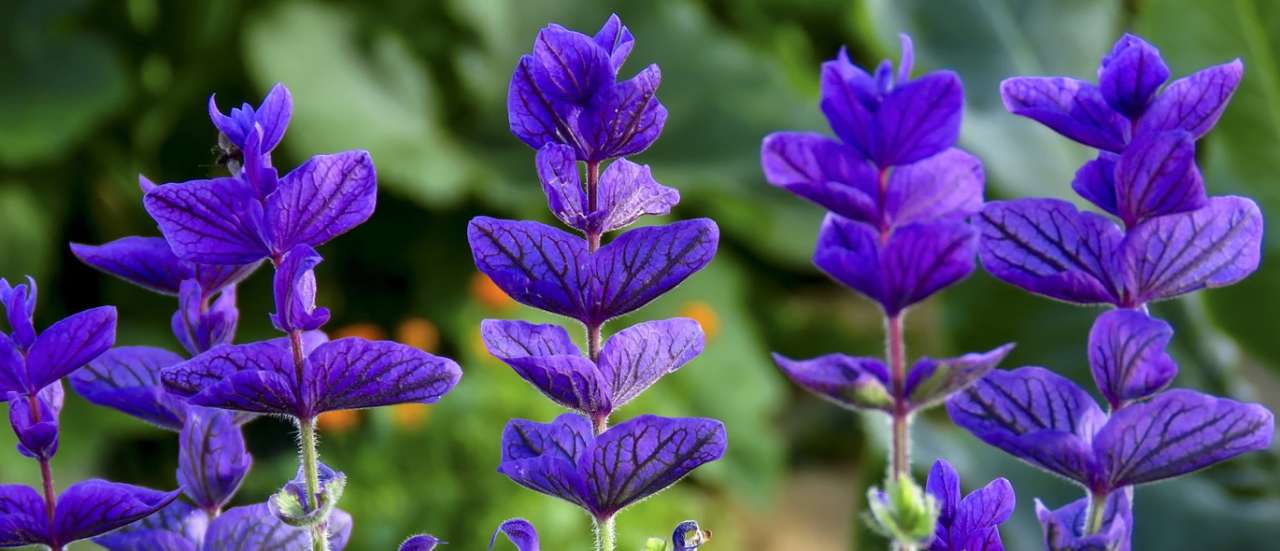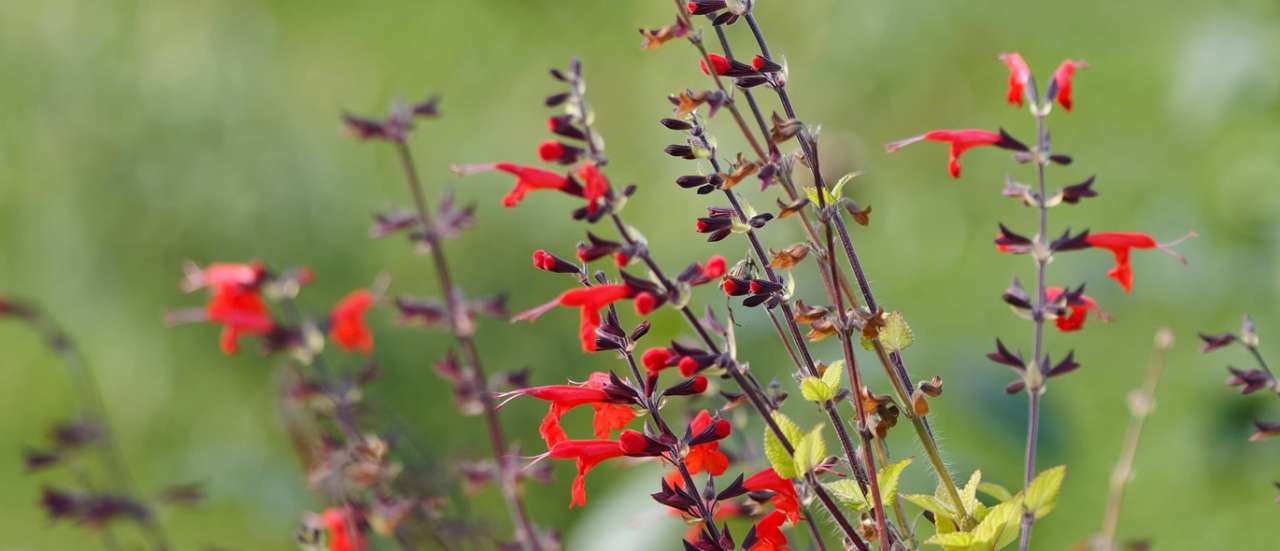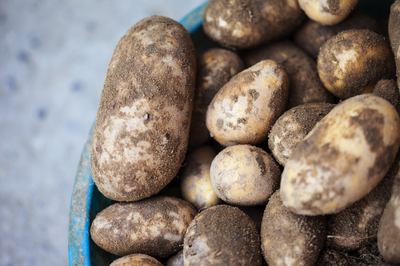Salvias are a hugely popular plant that suit pretty much any garden style, looking particularly well in cottage garden, Mediterranean, gravel and wildlife garden planting schemes. Most are well suited to coastal areas and all are perfect for attracting pollinators to a garden. These versatile plants look great in a mixed herbaceous or shrub border, can be used to underplant roses, grown in stand alone pots or planted as part of a container display. Not just loved by gardeners, salvias are also loved by bees and other pollinators. Then of course there are the culinary varieties, salvia officionalis or salvia purpurea, the leaves of which can be used in a variety of recipes and even have some medicinal uses.
It is always good to pay attention to the variety of salvia as some are hardier than others, with many requiring some winter protection or at least a free draining soil in a sheltered position. The distinctive, lipped flowers come in colours ranging from white to deep purple, blue, pink and red with some, like 'Hot Lips' having a bi-colour flower and the foliage is often quite fragrant. There are even annual varieties that provide vibrant summer colour as bedding plants.

Where and How to grow:
All salvias will perform well in well-drained, stony and often poor soils in a sunny position. It is important however to check the variety and details when purchasing as this will make a difference in terms of their suitability for the area you are looking to plant up. More tender varieties like Salvia 'Armistad' look wonderful in borders but, whilst they may survive a very mild winter, they are best lifted and overwintered in a greenhouse or cool conservatory. Even better these kinds of salvia can be planted in containers, positioned where you want them in summer and then moved to frost free conditions over the winter. More 'shrubby' varieties like Salvia 'Hot Lips' or 'Caradonna' are more suitable for growing outdoors all year round but still prefer a sheltered position whereas a variety like 'Mainacht' is considered fully hardy and will tolerate more exposure.
If your soil leans more towards the 'heavy clay' end of the spectrum then you will definitely need to improve the drainage prior to planting as most salvias will not survive a wet winter in waterlogged soil.
Annual salvias can often be bought in packs and we often stock these in late spring or early summer. These don't tend to be part of our online offering as they are too fragile to post, but you will often find them in our Boyle and Roscommon store as part of our bedding pack selection. You would usually plant these out as soon as they are purchased and use them to fill gaps in borders, as border edging or in container displays for adding colour for the summer season
Planting Perennial Herbaceous or Shrubby Salvias:
- Plant in a free draining soil in a sunny position, or if you have heavier soil, add plenty of horticultural grit to aid drainage. Dig a hole as deep as the pot they are in and up to twice as wide.
- There is no real need to add organic matter or compost as most salvias will thrive on pretty poor soils. It may be worth just giving the plants a trim though, before planting, to encourage bushy growth.
- Remove the plant from its pot, loosening any roots that may have become pot-bound (it's always good practice to give the pot a good watering an hour or so beforehand).
- Position the root-ball to the centre of the hole, making sure that the ground is level with the soil level in the pot – be sure not to plant it any deeper.
- Once positioned, you can then start to backfill the hole, gently firmly the plant in give it a good watering.
- If you're planting your perennial salvias in containers, mix some multi-purpose compost with some loam and add some grit for drainage, making sure that there are drainage holes in the container and that these are not blocked when placed on the ground. You may need some 'pot feet' to raise a pot if the drainage holes will otherwise become blocked.
Salvia care:
Once established these plants will rarely need watering even in dry conditions. Any cutting back should be done in spring as this provides extra winter protection from any sustaining foliage, but as mentioned before, more tender varieties will need protection and should really be moved to a cool greenhouse or frost free conditions.
Salvias rarely suffer issues with pests and diseases
Propagation: To ensure a good supply and guarantee you have salvias year after year, it is best to propagate salvias from cuttings in April, August or September.
- Cut off a non-flowering stem about 3-4 inches long (8-10cm) and strip the stem leaving only two or three leaves at the top. For larger leaved varieties it is best to cut the leaves in half so the cutting doesn't loose too much moisture
- Prepare a pot with seed and cutting compost, preferably with some perlite or grit added for drainage and add your cuttings around the edge of the pot. If your using say, a 9cm diameter pot you can often get 3-5 cuttings in each pot.
- Then you can cover the pot in a clear plastic bag, or, you can take an empty plastic water bottle, cut it in half and place one half over the pot like a mini propagator. If you use the half with the lid, you can even open the lid occasionally to allow air circulation and prevent too much moisture build up.
- Keep in a cool shady area of a green house or north facing windowsill. Check after about 3 weeks to see if there are any roots emerging at the bottom of the pot. Once you see these you can pot the cuttings on
Planting Companions
The key thing with planting 'companions' is to ensure you put plants together that thrive in similar conditions, so with salvias you will need plants that like well drained soil, preferably in a sunny position and aren't too fussy about the soil quality.
- Ornamental Grasses
Grasses like Stipa Tenuissima, and other smaller ornamental grasses can look great planted with salvia if you're looking for a prairie style planting scheme. You can even mix these in with the likes of eryngiums or echinacea to add even more colour and texture. - Orange Flowering Plants
Orange flowering plants like many heleniums, geums and calendula look beautiful planted with salvias. Positioned amongst purple or blue varieties such as 'Caradonna' or 'Amethyst', they provide an eye-catching contrast and with red varieties like 'Royal Bumble' or 'Hot Lips', can turn up the heat in a 'hot' coloured border. - Roses
Salvias look lovely planted around roses and, depending on the colours chosen, they can really set the tone of the garden. Make sure you check the variety of salvia though as a more hardy variety is probably better planted with roses, if you want to leave them in the ground over winter, because roses tend to like some moisture and a richer soil.
You can check out our current range of salvias online here or visit us in store where we have a wide range of shrubs and perennials to suit your garden needs











